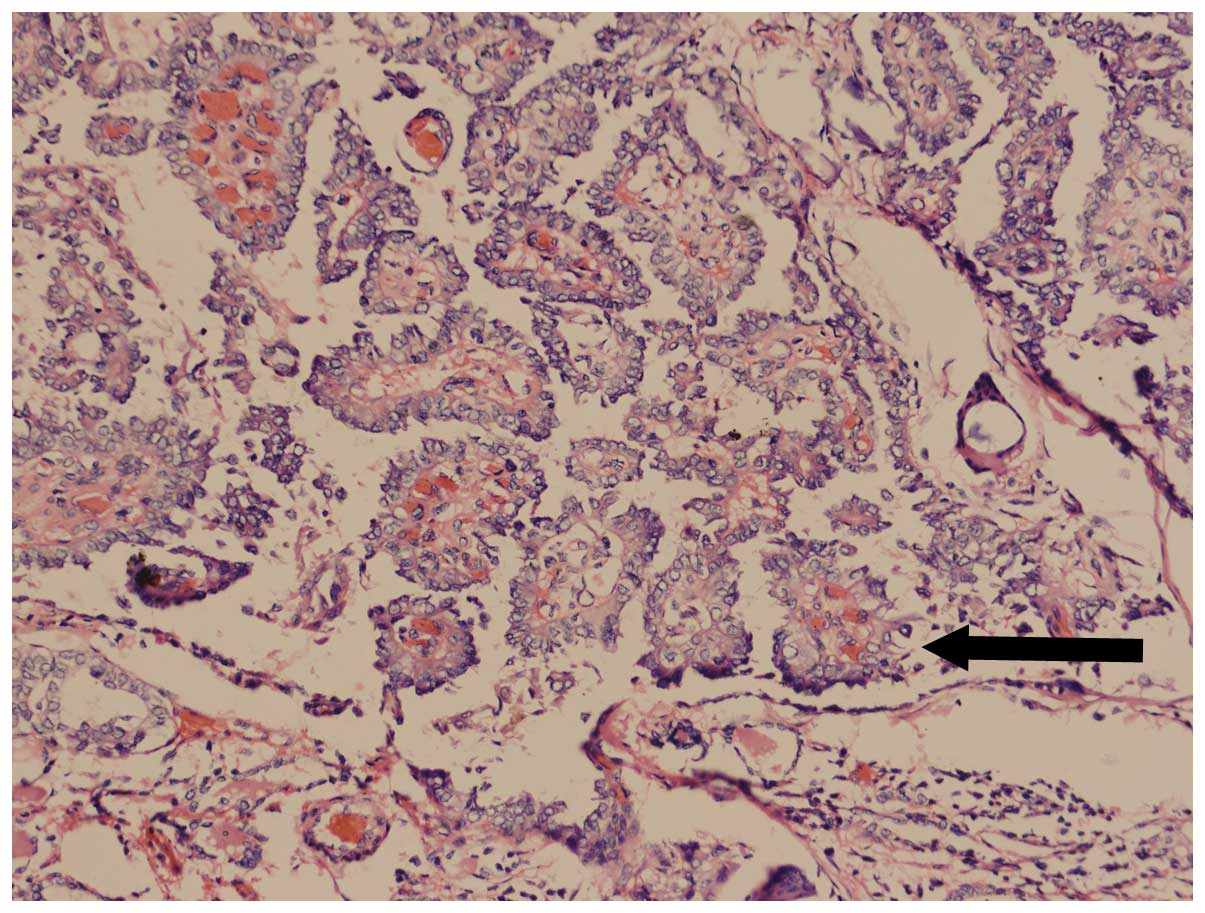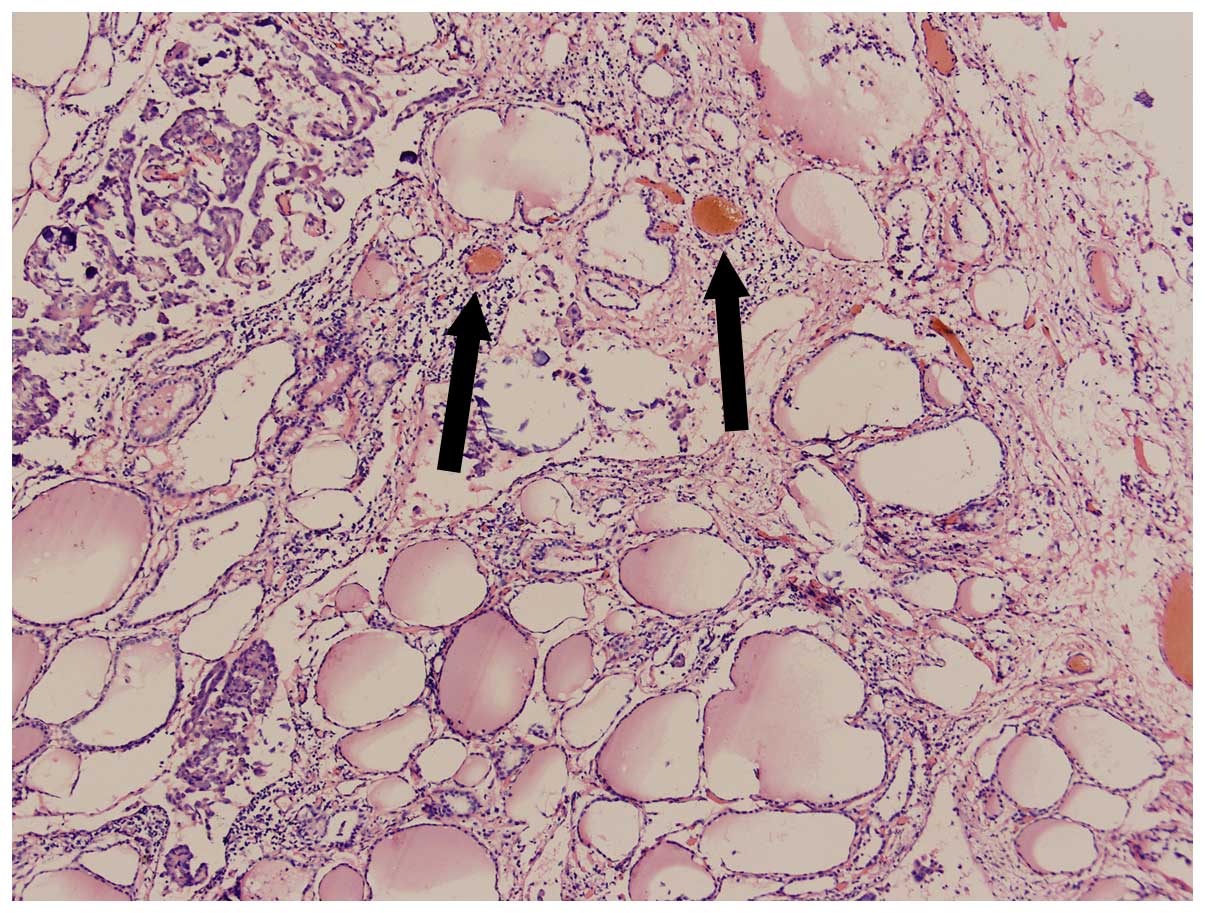Hashimoto's thyroiditis and papillary carcinoma in an adolescent girl: A case report
- Authors:
- Published online on: May 11, 2016 https://doi.org/10.3892/mco.2016.895
- Pages: 129-131
Abstract
Introduction
Hashimoto's thyroiditis is autoimmune thyroid disease in children. The most principal locations of pediatric thyroid disease is in iodine-sufficient areas worldwide (1). At the time of diagnosis, thyroid function of children and adolescent with Hashimoto's thyroiditis may significantly vary in the different pediatric reports, ranging from euthyroidism to overt hypothyroidism or occasionally, hyperthyroidism (2–7). Epidemiological data showed that thyroid cancer frequently occurs in the context of one of the most common autoimmune thyroid diseases, Hashimoto's thyroiditis (8). The possible association between Hashimoto's thyroiditis (HT) and papillary thyroid carcinoma (PTC) remains controversial. The association between HT and PTC is also supported by the observation that rearrangements of the rearranged during transfection (RET) oncogene is frequently detected in PTC (9).
Case report
A 15-year-old adolescent girl was admitted to a local hospital and a left neck mass (~1.0×1.5 cm2) was found one year ago. The mass was not accompanied by pain, itching, chills, fever and cough; however, the girl did experienced weight loss, heat intolerance and sweating. The patient had taken Chinese herbal medicine, however this had no effect. She visited a local hospital for treatment 9 months ago. Physical examination revealed the painless left goiter ~1.5×1.5 cm2, without vascular murmur. Laboratory examination results revealed normal thyroid function, anti-thyroglobulin antibody (TG-Ab) of 52.35% (<30%) and anti-thyroid microsomal antibody (TM-Ab) of 37.01% (<20%). The neck ultrasound examination revealed no thyroid lesions. It was diagnosed as Hashimoto's thyroiditis. After 3 months of observation, the neck mass had grown. The neck ultrasound examination revealed that a left lobe of the thyroid exhibited multiple solid hypoechoic nodules and calcification to the left neck lymph nodes. The right thyroid lobe and isthmus were normal. A lymph node biopsy revealed carcinoembryonic antigen (CA)125, 173.52 U/ml (0–35) and left neck metastasis were observed in papillary thyroid carcinoma. Possible diagnoses were: i) Left cervical lymph node metastatic papillary adenocarcinoma; ii) left thyroid cancer; iii) Hashimoto's thyroiditis. Surgery was performed and the total left thyroid lobe and most of the right lobe were resected. Pathological examination indicated that the patient was suffering from papillary thyroid carcinoma (Figs. 1 and 2), with cervical lymph node metastasis. Following chemotherapy and appropriate symptomatic treatment, the patient recovered well.
Discussion
Hashimoto's thyroiditis, also termed chronic lymphocytic thyroiditis, an autoimmune disease, is the most common cause of hypothyroidism in children and adolescents. Previous histological investigations demonstrated that lymphocyte infiltration accompanied lymphoid follicles. In recent years, as a result of the popularity of TM-Ab and TG-Ab, more cases are being identified. It has been shown that ~1% of school children are diagnosed with Hashimoto's thyroiditis. It is common children between 6 and 16-years-old, particularly 10–11 year-old and those in the peak of puberty. Females are more likely to have this disease comapred with males, the ratio being ~4–9:1. Hashimoto's thyroiditis develops slowly and is normally only diagnosed when the patient visits the hospital due to of thyroid goiter. Generally, no symptoms are exhibited, and only 8% suffer from hyperthyroidism and ~8% of patients finally get hypothyroidism. Therefore, symptoms are associated with the disease duration and thyroid functionality.
Thyroid cancer accounts for ~1% of all cancer cases. Papillary adenocarcinoma is widely distributed among all ages, from children <10-years-old to centenarians (10). Childhood thyroid carcinoma reveals an increasing trend. The Beijing Children's Hospital (Beijing, China) pathologically confirmed 10 thyroid cancer cases (0.7% in 1,379 malignancies). Other reports indicated that these cases occur in ~3.7–5% children <15-years-old. Thyroid cancer is common in 10–14-year-olds, particularly girls. The ratio between male to female is 1:2-3. More reported Hashimoto's thyroiditis merger thyroid cancer cases are identified in adults, where as very few cases are reported in children. Japan reported only one case in a child in 2003 (11), and no child cases have been reported in China.
Hashimoto's thyroiditis with thyroid cancer pathogenesis remains unclear. Many hypotheses exist as to why Hasimoto's thyroiditis occurs. It is possible that Hashimoto's thyroiditis is thyroid chronic inflammation, which causes the thyroid gland structural damage and affects thyroid hormone production negative feedback to stimulate thyroid-stimulating hormone (TSH) secretion. Long-term high levels of TSH stimulation in the goiter may stimulate thyroid cancer (12). It is also possible that the patient with Hashimoto's thyroiditis has organ-specific suppressor T lymphocyte dysfunction, which reduces the role of local immune surveillance and leads to the occurrence of thyroid cancer. Molecular biology investigations also found that p53, B-cell lymphoma-2 and RET genes are closely associated with the incidence of thyroid cancer (13,14), providing another possibly explanation. Hashimoto's thyroiditis is often accompanied with a large number of lymphoid tissue cell infiltration and lymphoid follicles. Chronic antigenic stimulation may cause neoplastic hyperplasia of thyroid follicular, and thus malignant transformation. Finally, high iodine intake significantly increased the risk of thyroid cancer. This also increased the incidences of Hashimoto's thyroiditis, which may easily lead to iodine and thyroid epithelial cell injury, and immune dysfunction.
As a result of the complexity of the clinical manifestations of Hashimoto's thyroiditis, it can be expressed as not only hyperthyroidism or hypothyroidism, but also normal thyroid function. Notably, the most common cases exhibit hypothyroidism. Long-term treatment, and for children with thyroid cancer, early diagnosis, is particularly difficult. In the present case, the diagnosis of Hashimoto's thyroiditis is primarily based on the clinical manifestations, TG-Ab and TM-Ab. The only diagnostic imaging ultrasound was negative (data not shown). The patient did not undergo fine needle aspiration cytology diagnosis of the disease. Therefore, this child may be exhibiting one of two situations: i) Hashimoto's thyroiditis, which develops into thyroid cancer later; ii) thyroid cancer, with Hashimoto's thyroiditis being diagnosed at the early stages. The present study hypothesized that in either case, the clinical diagnosis of thyroid disease provide a warning for the early diagnosis of Hashimoto's thyroiditis. Following treatment or regular observation, if no significant improvement is observed, the emergence of nodules evident in children can be an alert to the possibility of the coexistence of tumor nature. To improve the diagnosis accuracy, besides detailed examination, the necessary laboratory examinations, including ultrasound, computed tomography and other imaging methods, must be performed. Ultrasound-guided fine needle aspiration cytology prior to surgery can assist with identifying the disease (15).
Acknowledgements
The present study was supported by a grant from Chengdu Science and Technology Bureau project of China (no. 2014-HM01-00052-SF).
Glossary
Abbreviations
Abbreviations:
|
TG-Ab |
anti-thyroglobulin antibody |
|
TM-Ab |
anti-thyroid microsomal antibody |
|
CA125 |
carcinoembryonic antigen 125 |
References
|
Wasniewska M, Vigone MC, Cappa M, Aversa T, Rubino M and De Luca F: Study Group for Thyroid diseases of Italian Society for Pediatric Endocrinology: Acute suppurative thyroiditis in childhood: relative frequency among thyroid inflammatory diseases. J Endocrinol Invest. 30:346–347. 2007. View Article : Google Scholar : PubMed/NCBI | |
|
Zak T, Noczyńska A, Wasikowa R, Zaleska-Dorobisz U and Golenko A: Chronic autoimmune thyroid disease in children and adolescents in the years 1999–2004 in Lower Silesia, Poland. Hormones. 4:45–48. 2005. View Article : Google Scholar : PubMed/NCBI | |
|
Gopalakrishnan S, Chugh PK, Chhillar M, Ambardar VK, Sahoo M and Sankar R: Goitrous autoimmune thyroiditis in a pediatric population: a longitudinal study. Pediatrics. 122:e670–e674. 2008. View Article : Google Scholar : PubMed/NCBI | |
|
Demirbilek H, Kandemir N, Gonc EN, Ozon A and Alikasifoglu A: Assessment of thyroid function during the long course of Hashimoto's thyroiditis in children and adolescents. Clin Endocrinol. 71:451–454. 2009. View Article : Google Scholar | |
|
Skarpa V, Kappaousta E, Tertipi A, Anyfandakis K, Vakaki M, Dolianiti M, Fotinou A and Papathanasiou A: Epidemiological characteristics of children with autoimmune thyroid disease. Hormones. 10:207–214. 2011. View Article : Google Scholar : PubMed/NCBI | |
|
Özen S, Berk Ö, Şimşek DG and Darcan S: Clinical course of Hashimoto's thyroiditis and effects of levothyroxine therapy on the clinical course of the disease in children and adolescents. J Clin Res Pediatr Endocrinol. 3:192–197. 2011. View Article : Google Scholar : PubMed/NCBI | |
|
De Luca F, Santucci S, Corica D, Pitrolo E, Romeo M and Aversa T: Hashimoto's thyroiditis in childhood: presentation modes and evolution over time. Italian Journal of Pediatrics. 39:82013. View Article : Google Scholar : PubMed/NCBI | |
|
Guarino V, Castellone MD, Avilla E and Melillo RM: Thyroid cancer and inflammation. Molecular and Cellular Endocrinology. 321:94–102. 2010. View Article : Google Scholar : PubMed/NCBI | |
|
Mechler C, Bounacer A, Suarez H, Saint FM, Magois C, Aillet G and Gaulier A: Papillary thyroid carcinoma: 6 cases from 2 families with associated lymphocytic thyroiditis harbouring RET/PTC rearrangements. Br J Cancer. 85:1831–1837. 2001. View Article : Google Scholar : PubMed/NCBI | |
|
Repplinger D, Bargren A, Zhang YW, Adler JT, Haymart M and Chen H: Is Hashimoto's thyroiditis a risk factor for papillary thyroid cancer? J Surg Res. 150:49–52. 2008. View Article : Google Scholar : PubMed/NCBI | |
|
Yagasaki H, Inukai T, Uno K, Akahane K, Nemoto A, Takahashi K, Sato H, Goi K, Mouri N, Takano K, et al: Development of severe aplastic anemia in a girl with Hashimoto's thyroiditis and papillary thyroid carcinoma. Rinsho Ketsueki. 44:328–333. 2003.(In Japanese). PubMed/NCBI | |
|
Fiore E, Rago T, Latrofa F, Provenzale MA, Piaggi P, Delitala A, Scutari M, Basolo F, Di Coscio G, Grasso L, et al: Hashimoto's thyroiditis is associated with papillary thyroid carcinoma: Role of TSH and of treatment with L-thyroxine. Endocr Relat Cancer. 18:429–437. 2011. View Article : Google Scholar : PubMed/NCBI | |
|
Burstein DE, Nagi C, Wang BY and Unger P: Immunohistochemical detection of p53 homolog p63 in solid cell nests, papillary thyroid carcinoma and hashimoto's thyroiditis: A stem cell hypothesis of papillary carcinoma oncogenesis. Hum Pathol. 35:465–473. 2004. View Article : Google Scholar : PubMed/NCBI | |
|
Kang DY, Kim KH, Kim JM, Kim SH, Kim JY, Baik HW and Kim YS: High prevalence of RET, RAS and ERK expression in Hashimoto's thyroiditis and in papillary thyroid carcinoma in the Korean population. Thyroid. 17:1031–1038. 2007. View Article : Google Scholar : PubMed/NCBI | |
|
Haberal AN, Toru S, Ozen O, Arat Z and Bilezikçi B: Diagnostic pitfalls in the evaluation of fine needle aspiration cytology of the thyroid: Correlation with histopathology in 260 cases. Cytopathology. 20:103–108. 2009. View Article : Google Scholar : PubMed/NCBI |











